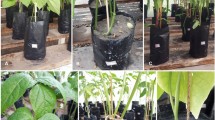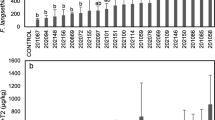Abstract
Mycotoxins, such as aflatoxins and ochratoxins, are widely distributed in nature and are frequently problematic crop contaminants that cause millions of dollars of annual losses in the United States. Insect infestations of crop plants significantly exacerbate mycotoxin contamination. Damage to a variety of nut species by Amyelois transitella Walker (navel orangeworm, NOW) is associated with infection by Aspergillus species and concomitant production of aflatoxins and ochratoxins. Resistance to aflatoxins in this lepidopteran is compared here with the levels of resistance in Helicoverpa zea (corn earworm, CEW), another lepidopteran that routinely encounters aflatoxins in its diet, albeit at lower levels. Measured as the developmental delay caused by aflatoxin B1 (AFB1), it is apparent that the LC50 (defined as the concentration preventing 50% of newly hatched larvae from entering the 2nd instar within 48 h) for AFB1 is 100 times greater for A. transitella than for H. zea. Similarly, A. transitella 1st instars display substantially higher tolerance to ochratoxin A, another mycotoxin contaminant produced by Aspergillus species, than do H. zea. Our studies indicate that A. transitella, although a hostplant generalist, may well be highly specialized for mycotoxin detoxification.


Similar content being viewed by others
References
Archer, T. L., and Bynum, Jr. E.D. 1994. Corn earworm (Lepidoptera: Noctuidae) biology on food corn on the High Plains. Environ. Entomol. 23:343–348.
Bayman, P., and Baker, J. L. 2006. Ochratoxins: a global perspective. Mycopathologia 162:215–23.
Buetler, T. M, Slone, D., and Eaton, D. L. 1992. Comparison of the aflatoxin Bl-8,9-epoxide conjugating activity of two bacterially expressed alpha class glutathione S-transferase isozymes from mouse and rat. Biochem. Biophys. Res. Commun. 188:597–603.
Burks, C. S., and Brandl, D. G. 2004. Seasonal abundance of the navel orangeworm, Amyelois transitella, in figs and the effect of peripheral aerosol dispensers on sexual communication. J. Insect. Sci. 4:40–47.
Campbell, B. C., Molyneux, R. J., and Schatzki, T. F. 2003. Current research on reducing pre- and post-harvest aflatoxin contamination of US almond, pistachio, and walnut. J. Toxicol.:Toxin Reviews 22:225–266.
Chinnici, P. J., and Llewellyn, C. G., 1979. Reduced aflatoxin toxicity in hybrid crosses of aflatoxin B, sensitive and resistant strains of Drosophila melanogaster (Diptera). J. Invert. Pathol., 27:255–258.
Chinnici, J.P., Booker M.A., Llewellyn G. C., 1976. Effect of aflatoxin B1 on viability, growth, fertility, and crossing over in Drosophila melanogaster (Diptera). J. Invert. Pathol., 27:255–258.
Cleveland, T.E., Dowd, P.F., Desjardins, A.E., Bhatnagar, D., and Cotty, P.J. 2003. United States Department of Agriculture-Agricultural Research Service research on pre-harvest prevention of mycotoxins and mycotoxigenic fungi in US crops. Pest Manag. Sci. 59:629–642.
Connell, J. H. 2001. Leading edge of plant protection for almond. Hort. Technology 12:619–622.
Eaton, L.D., and Gallagher, P. E. 1994. Mechanisms of aflatoxin carcinogenesis. Annu. Rev. Pharmacol. Toxicol. 34:135–172.
Gudauskas, R. T., Davis, N. D., Diener, U. L., 1967. Sensitivity of Heliothis virescens larvae to aflatoxin in ad libitum feeding. J. Invert. Pathol., 9:132–133.
Guengerich, F. P., Johnson, W. W., Shimada, T., Ueng, Y. F., Yamazaki, H., and Langouet, S. 1998. Activation and detoxication of aflatoxin B1. Mutat. Res. 402:121–128.
Hayes, J. D., Flanagan, J. U., and Jowsey, I. R. 2005. Glutathione transferases. Annu. Rev. Pharmacol. Toxicol. 45:51–88.
Johnson, W. W., Ueng, Y. F., Widersten, M., Mannervik, B., Hayes, J. D., Sherratt, P. J., Ketterer, B., and Guengerich, F. P. 1997. Conjugation of highly reactive aflatoxin B1 exo-8,9-epoxide catalyzed by rat and human glutathione transferases: estimation of kinetic parameters. Biochemistry 36:3056–3060.
Lee, S.E., and Campbell, B. C. 2000. In vitro metabolism of aflatoxin B1 by larvae of navel orangeworm, Amyelois transitella (Walker) (Insecta, Lepidoptera, Pyralidae) and codling moth, Cydia pomonella (L.) (Insecta, Lepidoptera, Tortricidae). Arch. Insect Biochem. Physiol. 45:166–174.
Llewellyn, C.G., and Chinnici, P.J.,1978. Variation in sensitivity to aflatoxin B, among several strains of Drosophila melanogaster (Diptera). J. Invert. Pathol. 31: 37–40.
Lotlikar, P. D., Jhee, E. C., Insetta, S. M., and Clearfield, M. S. 1984. Modulation of microsome-mediated aflatoxin Bl binding to exogenous and endogenous DNA by cytosolic glutathione S-transferases in rat and hamster livers. Carcinogenesis 5:269–276.
Manderville, R. A. 2005. A case for the genotoxicity of ochratoxin A by bioactivation and covalent DNA adduction. Chem. Res. Toxicol. 18:1091–7.
McLean, M., and Dutton, M. F. 1995. Cellular interactions and metabolism of aflatoxin: an update. Pharmacol. Ther. 65:163–192.
Monroe, D. H., and Eaton, D. L. 1988. Effects of modulation of hepatic glutathione on biotransformation and covalent binding of aflatoxin Bl to DNA in the mouse. Toxicol. Appl. Pharmacol. 94:118–127.
Neal, G. E. 1995. Genetic implications in the metabolism and toxicity of mycotoxins. Toxicol. Lett. 82–83:861–867.
Niu, G., Wen, Z., Rupasinghe, S.G., Zeng, R.S., Berenbaum, M.R., and Schuler M. A. 2008. Aflatoxin B1 detoxification by CYP321A1 in Helicoverpa zea. Arch. Insect Biochem. Physiol. 69:32–45.
Otsuki, T., Wilson, S. J., and Sewadeh, M. 2001. Saving two in a billion: quantifying the trade effect of European food safety standards on African exports. Food Policy 26: 495–514.
Palumbo, J. D., Mahoney N. E., and Light, D. M. 2008. Navel orangeworm (Amyelois transitella) as a vector of Aspergillus flavus on almonds. Phytopathology 98:S119.
Park, D. L., and Troxell, T. C. 2002. U.S. perspective on mycotoxin regulatory issues. Adv. Exp. Med. Biol. 504:277–285.
Schade, J. E., McCreev, Y. K., King, A. D., Mackey, B., and Fuller, G. 1975. Incidence of aflatoxin in California almonds. Appl. Microbiol. 29:48–53.
Schatzki, T. F., and Ong, M. S. 2000. Distribution of aflatoxin in almonds. 2. Distribution in almonds with heavy insect damage. J. Agric. Food Chem. 48:489–492.
Schatzki, T. F., and Ong, M. S. 2001. Dependence of aflatoxin in almonds on the type and amount of insect damage. J. Agric. Food Chem. 49:4513–4519.
Schaut, A., De Saeger, S., Sergent, T., Schneider, Y. J., Larondelle, Y., Pussemier, L., Blank, R., and Van Peteghem, C. 2008. Liquid chromatographic methods for biotransformation studies of ochratoxin A. Biomed. Chromatogr. 22:1013–1020.
Suriawinata, A., and Xu, R. 2004. An update on the molecular genetics of hepatocellular carcinoma. Semin. Liver Dis. 24:77–88.
Tebbets, J.S., Curtis, C.E., and Fries, R.D. 1978. Mortality of immature stages of the navel orangeworm stored at 3.5°C. J. Econ. Entomol. 71:875–876.
Weis, A. E.1982. Use of a symbiotic fungus by the gall maker Asteromyia carbonifera to inhibit attack by the parasitoid Torymus capite. Ecology 63:1602–1604.
Widstrom, N. W. 1979. The role of insects and other plant pests in aflatoxin contamination of corn, cotton, and peanuts—a review. J. Environ. Qual. 8:5–11.
Widstrom, N. W., Lillehoj, B. E., Sparks, N. A., and Kwolek, F. W. 1976. Corn earworm damage and aflatoxin B, on corn ears protected with insecticide. J. Econ. Entomol. 69:677–679.
Williams, J. H., Phillips, T. D., Jolly, P. E., Stiles, J. K., Jolly, C. M., and Aggarwal, D., 2004. Human aflatoxicosis in developing countries: a review of toxicology, exposure, potential health consequences, and interventions. Am. J. Clin. Nutr. 80:1106–1122.
Zeng, R. S., Niu, G., Wen, Z., Schuler, M. A., and Berenbaum, M. R. 2006. Toxicity of aflatoxin B1 to Helicoverpa zea and bioactivation by cytochrome P450 monooxygenases. J. Chem. Ecol. 32:1459–1471.
Acknowledgments
We thank Dr. Rensen Zeng and Dr. Zhimou Wen for advice and assistance in the design, execution, and analysis of bioassays. Also, we thank Allen Lawrance for assistance with colony maintenance. This project was funded by a grant from the Almond Board of California (ABC-C6480).
Author information
Authors and Affiliations
Corresponding author
Rights and permissions
About this article
Cite this article
Niu, G., Siegel, J., Schuler, M.A. et al. Comparative Toxicity of Mycotoxins to Navel Orangeworm (Amyelois transitella) and Corn Earworm (Helicoverpa zea) . J Chem Ecol 35, 951–957 (2009). https://doi.org/10.1007/s10886-009-9675-8
Received:
Revised:
Accepted:
Published:
Issue Date:
DOI: https://doi.org/10.1007/s10886-009-9675-8




